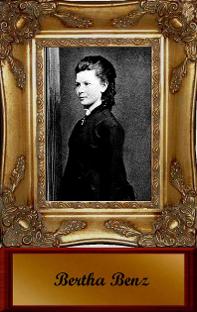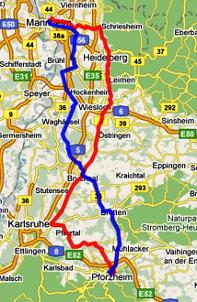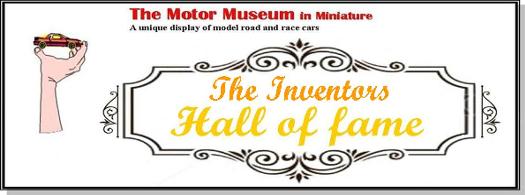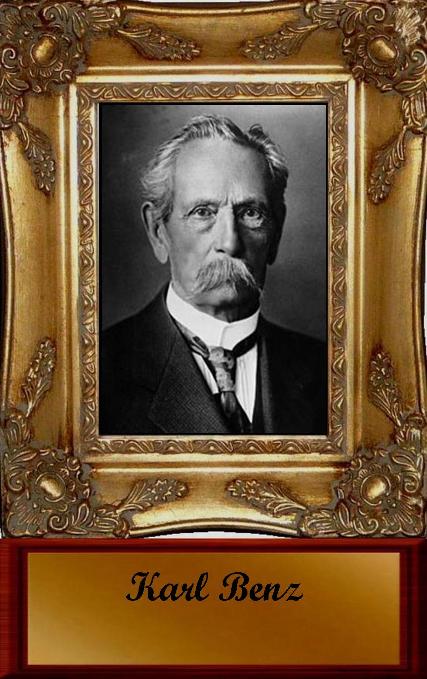
MMIM Hall of Fame
Dr. Carl Benz

The question of who invented the motor car is usually answered with the name Karl Benz. Depending on the definition you prefer or the method of propulsion specified, and so on, you might find Ferdinand Verbiest, William Murdoch, Richard Trevithick, Goldsworthy Gurney, Étienne Lenoir or Siegfried Marcus cited as the first to build an automobile. All the former, and others, built automotive vehicles of different types before Benz. So why does Karl Benz get the credit?
Answer; because his vehicle was a totally original design incorporating many Benz patents, it was run more extensively and proved more reliable, than anything that came before and was put into production, albeit on a small scale to our minds.
However, the manner of getting from humble boy to world renowned engineer (whose name lives on the luxury Mercedes-Benz brand) wasn’t in anyway an easy voyage.
The story starts with Karl Benz’ parents and family; not even this is an easy issue to negotiate. Karl’s mother was Josephine Vaillant, born, according to parish registers in Landstuhl, Kaiserslautern, Deutschland, on the 8th of April, 1804. Her father Philipp Vaillant was a Gendarme in the recently constituted National Gendarmerie, his service was in Napoleon’s Grande Armée and he never returned from the disastrous Russian campaign of 1812. Little is known about her mother Johanna Katharina Vaillant, née Vuillemin.
Johann Georg Benz was born to Johann Michael Benz and Maria Anna Benz, née Schottmüller, on the 7th of January 1809 in Burbach, Karlsruhe, Deutschland. He was baptized on the 8th January of 1809. There are references to both Johann Georg and Johan Michael being blacksmiths but no definitive evidence. All this does at least suggest an engineering background to which Karl Benz might owe his intuitive engineering abilities.
A year later, on the 16th of November, 1845, Josephine Vaillant married Johann Georg Benz in the Catholic parish Church of St. Stephen, Karlsruhe. Karl’s surname therefore became Benz under German law due to the legal marriage of his parents.
The family remained in the Karlsruhe Mühlburg district, at Erbprinzenstrasse 13, Karlsruhe, but was to endure great tragedy just 8 months later when Johan Georg Benz died on the 21st of July, 1846. Circumstances surrounding the cause of his death are variously reported as a railway accident or as pneumonia contracted from working in the open cabs of the steam locomotives of the day. There is of course the possibility an accident debilitated Johan and the weakened, bed bound man developed pneumonia due to enforced inactivity. Whatever the cause, Karl was less than two years old and already facing an even tougher future without a father.
Now we pause for little confusion; Johan Benz is sometimes recorded as father to Karl and Anton Benz, and some sources even report Karl Benz had 3 siblings. It is possible that Josephine could have had another child during the marriage, but records of such are not forthcoming. Furthermore, Johan Benz has his own siblings recorded as Maria Josepha Benz, Anton Benz and Magdalena Benz. In both cases the birth and death dates of the “Anton” in question are unknown, was there one Anton, or two? There seems no evidence of any third, or fourth, child for Johan Georg Benz, he was five years younger than Josephine and only 36 years old when he died. The possibility does remain that one, or both, parents had children from previous relationships, but authoritative evidence has not yet presented itself.
Now widowed, Josephine Benz was left to bring up Karl largely on her own. Finances must have been very hard indeed. It is known that Josephine gave board and lodgings to students from the Karlsruhe polytechnic, received an annual widow’s pension of 76Florins & 48Cruisers from the Baden Railway company and she still had to go out to work (apparently, she was a superb cook).
Somehow Josephine managed, and despite living in near poverty, Josephine always made the education of her son Karl her top priority. Since education was mandatory for all German children between the age of five and 14-years-old, Karl had to go to school. Wanting the best education meant money, there were free schools for the working class but the best education required money to attend the best teaching establishments. Due to lack of evidence to the contrary one imagines the young Karl attended a free school for his primary education. What is know from his later schooling was that Karl Benz was an exemplary student. He was good enough to attend the science-oriented Gymnasium in Karlsruhe (Gymnasium was the term for a secondary education establishment at the equivalent level to a British Grammar School, they are also called Lyceum). That meant money had to be found and true to her word Josephine paid for the best education that she could afford. So, in 1853, aged just nine years old, Karl Benz was in the top-tier of German secondary schools.
Karl was noted as a prodigious student, deeply interested in watch and clock repairs and had been considering becoming a locksmith. He studied chemistry and physics at such an excellent level that in a few years he was appointed as an ‘assistant’ to the master of physics. At home he spent many hours conducting his own chemistry experiments and even transformed a small room of his mother’s house into a laboratory.
At the end of seven years of Secondary education a 15-year-old Karl Benz sat the entrance exam to study mechanical engineering at the up and coming Karlsruhe Polytechnic College. Of course, he passed, and commenced his University level education on the 30th of September, 1860. Money remained an issue for the Benz household but now Karl was starting show and entrepreneurial spirit of his own. In the 1860s the bicycle was becoming popular and Karl became an avid rider. He still loved tinkering with watches and clocks, earning money for the home through his skill at repairing them, and was now to add another revenue stream. With his bicycle he not only learnt more about the latest engineering technology and design, he had the ability to roam the lanes of the lanes of the Black Forest region taking photographs of the villages and villagers, selling the photographs to enhance the household budget.
At the Polytechnikum Karlsruhe, Karl Benz was under the tutelage of the great professor Redtenbacher who was to have a profound effect on the future of Karl Benz. Ferdinand Jakob Redtenbacher (25-7-1809 to 16-4-1863), was the founder of scientific mechanical engineering and from 1841 held the position of professor in mechanics and mechanical engineering. From 1857 to 1862 Redtenbacher was the director of the Karlsruhe polytechnic and his influence raised a humble engineering college into a university of international standing. What was crucial to our story is that Ferdinand Redtenbacher believed steam power was a thing of the past. New technology was coming and Redtenbacher was filling his students with enthusiasm for it. For Karl Benz that meant automotive road transport. Something that anyone who has ridden a bicycle along country lanes for miles must have wished for at one time or another! It isn’t hard to imagine Benz struggling up a hill and thinking of ways to fit an engine to his bicycle to ease the strain on his aching legs.
Redtenbacher, who also taught Emil Skoda and Franz Reuleaux, served as the catalyst to Benz’ interest in the horseless carriage. Benz, ever the outstanding student, graduated with a degree in mechanical engineering on the 9th of July 1864, aged nineteen.
At this point it seems fitting to remember Josephine Benz’ vision and sacrifice, Karl certainly never forgot her importance, when talking of his mother many years later Benz said: "She was a key figure in my life." If Josephine was the first key figure, Redtenbacher was surely the second.
With the four years of high-level academic studying under his hat, Benz was now to undertake a further seven years of practical study professional training starting with two years at the Karlsruhe Maschinenbau-Gesellschaft (Mechanical engineering company). Karl worked long hours doing a variety of engineering tasks under generally poor conditions, what time he did have at home he spent sketching ideas for his horseless carriage.
In 1866 Benz moved to Mannheim and in 1967 was on the payroll of Johann Schweizer and Company. The firm produced cranes and wagons and provided Benz with his first paid employment, as a technical draftsman. Interestingly Karl’s mother Josephine Benz also moved to be with Karl in Mannheim in 1866. She would later move on to Gondelsheim in 1869 close to her sister Louisa Elisabetha Schnitt-Spanpan. This was not surprising as Karl had also moved on being no longer employed at Johann Schweizer and Co.
Karl’s mother Josephine Benz passed away on the 12th of March, 1870, in Gondelsheim. In her honour the Gondelsheim community later donated a head stone and named a street after her, "Josephine Benz Straße". Each year the historic Bertha Benz memorial event for vintage cars also makes a stop in Gondelsheim in memory of the woman who worked so hard to ensure Karl Benz had the necessary education which would later give the people of the world the freedom to travel where and when they wished.
Benz next job was for Gebrüder Benckiser Eisenwerke und Maschinenfabrik in Pforzheim. He spent two years there which must have been quite a chore, as this engineering company was primarily involved in bridge-building which can’t have been very inspiring for someone dreaming about automobiles. During this time Karl met Bertha Ringer, whom he was later to marry, so perhaps there was another reason for staying in a job he probably found a little boring.
Benz’ next job was in Vienna, this time for a relatively short period with an iron construction company before he returned to Mannheim. Karl was not really impressed with any of his previous jobs and knowing what his long-term dream was he must have often thought being his own boss would be easier.
In 1871, at the age of twenty-seven the technically-minded Benz founded his first company with a friend, allegedly a talented mechanic, August Ritter. “Carl Benz und August Ritter, Mechanische Werkstätte" worked from a plot of land known as T6, 11, Mannheim. It was a small engineering works, iron foundry and Mechanical workshop, later renamed, Factory for Machines for Sheet-metal Working. The company, mainly Benz himself, produced iron fittings and metal construction materials for the building trade.
Little seems to be known about August Ritter but we do know that, despite Benz’ hard work, the firm’s first year went very badly; So badly that local authorities had bailiffs confiscate the business’ tools. Clearly Ritter was not a reliable partner and he was soon wanting to leave the firm. This was acceptable to Benz but required a financial settlement that Benz himself could not find the funds for. However, Benz had a new collaborator, Cäcilie Bertha Ringer. The couple were now engaged and Bertha’s dowry was more than enough to put the company firmly in the couple’s hands. Without hesitation she used the dowry to buy Ritter out of the business. Bertha would not have been able to do this were it not still before their marriage; by law married women lost the legal power to act independently. All necessary steps were taken and Benz now had a partner with a vision and passion for the future which equalled his own. Bertha had taken the first step toward becoming the Mother of Motoring, the driving force so often found ‘behind every good man’.
The new company “Karl Benz, Eisengießerei und Mechanische Werkstätte” still found it hard to make ends meet. Benz worked long hours meeting orders and trying to find time to develop his ideas and carry out experimental work. He believed the future of powered machinery and mechanical transport was the two-stroke internal combustion engine, which Nikolaus Otto had ultimately been unsuccessful in perfecting. Karl Benz went straight to work on developing his plans to convert the design of the famous Otto four-stroke internal combustion engine. Years of hard work were to follow.
Quite how Benz found time to get married does make one wonder but Carl Benz and Cäcilie Bertha Ringer were indeed married on the 20th of July, 1872. Bertha (who was born on the 4th of May,1849, in Stadtkreis Pforzheim, Baden-Württemberg, Germany), was always in Benz’ corner, the pair had risked everything and despite being virtually penniless they dedicated themselves to making their dreams come true. While it would be 16 years of financial hardship before Benz made his automobile a reality, the couple didn’t waste time before starting a family. The first of their five children, Eugen Carl Benz arrived a year later on the 1st of May, 1873. He was followed by a second son, Richard Benz, on the 21st of October, 1874. Three daughters were then born into the Benz Family, Clara Josefine (Unger-) Benz, 1st of August, 1877. Mathilde Thekla ‘Thilde’ (Volk-) Benz, 2nd of February, 1882, and Ellen (Perron-) Benz on the 16th of March, 1890.
While we might suppose that Bertha would settle down to run the family, as Karl tinkered in the garage, it probably wasn't that way at all. Benz was known to work on the kitchen table and Bertha would later demonstrate exceptional knowledge of the automobiles design and practicalities, so it seems clear she was more heavily involved than one might assume.
Benz 2-stroke engine
While working to meet orders and develop new ideas Benz realised that if he patented all his inventions, he could make money off of them to help raise funds. Karl focused the firm's attention on creating a reliable gas two-stroke engine then development of new and better versions of it. Benz was following the two-stroke idea because the Deutz Gasmotorenfabrik had already been granted the patent for the four-stroke engine in 1877.
By selling stationary engines to local factories, to provide motive power, Benz’ company just got by; just! Despite a life in near poverty Benz worked diligently to keep developing his own internal combustion engine and automotive vehicle. By tackling one problem at a time he started to come up with new devices and ideas he would need for a motor car. Karl Benz’ engineering genius was starting to pay off as each perfected item was patented through 1878, including: An engine speed regulator system, a throttle system, a new carburettor, new electric battery and spark plugs for an electrical spark ignition system to induce combustion in the engine, a water radiator design for cooling purposes and a clutch and gear shift system for using more than one gear.
Each successive patent was maximized for income while Karl toiled to bring his engine to life. his associates objected, even called his fixation on an internal-combustion engine to revolutionize the world, "unbalanced". But Benz succeeded. On the 31st of December, 1878, New Year's Eve, the one-cylinder, two-stroke, liquid fuelled engine spluttered into life, and ran reliably.
The patent for his working engine was granted to Benz in 1879.
Gasmotoren-Fabrik Mannheim (1882–1883)
Far from a quick fix for the financial issues the high development and production costs led the Mannheim Bankers to pressure Benz into creating a new joint-stock company in 1882, the ‘Gasmotoren-Fabrik Mannheim’. This pressure also required additional financial backing and direction which brought Benz into partnership with Mannheim court photographer, Emil Bühler, and his brother, a cheese merchant.
After the necessary incorporation paperwork was completed Benz found he only had a 5% stake in ‘his’ company; he was but a ‘mere’ director, not the designer. His partners exerted increasing influence on his designs, so much so, Benz withdrew from the company just a year later, in 1883.
Benz & Cie. Rheinische Gasmotoren-Fabrik.
The technically-minded Karl Benz may have been a supremely talented engineer, but he was a terrible marketer. Using Bertha’s continued financial support (and business acumen) he formed a new manufacturing venture. On the 1st of October, 1883, Benz reached agreement with some old associates from his days enjoying cycling. Max Kaspar Rose and commercial agent Friedrich Wilhelm Eßlinger ran a business in Mannheim selling bicycles, spares and other associated mechanical items. This new company, Benz & Cie. had sufficient backing to really deliver the resources Benz needed to produce his static internal-combustion gas engines and extend the production facility at the T6, 11, Mannheim address. The employee number was a mere six persons but demand for the gas engines was soon outstripping the manpower and the number of workers grew to 25. As well as the growing income from sales Benz was also raising money by selling production licenses for the new gas engines. Karl Benz had finally founded a successful company, the company that would make his name and of which he would be a director until 1923.
Best of all, Benz now had more time, and money, to follow his lifelong ‘horseless carriage’ dream.
But his work was kept as secret as possible, had word leaked to the Bankers it is pretty certain they would have considered Benz a nutcase, far too much of a financial risk, and withdrawn their financial support.
The Benz Patent Motorwagen 3-wheel car
Free to devote himself entirely to the development of his motor car Benz ploughed ahead solving the myriad of problems required to produce such an invention. At the time there was little in the way of prior learning to build upon. Whether Benz even had knowledge of the earlier vehicles of Jean-Joseph Étienne Lenoir or Siegfried Marcus isn’t known. We do know Benz lived but 60 miles from fellow German, Gottlieb Daimler, who was also working on the same visionary idea and neither of them knew what the other was doing. Without knowing it Benz was in a race to deliver the world’s practical motor car. Incidentally, while Daimler ultimately lost that race to Benz, it was Daimler, working alongside Wilhelm Maybach, who put a high-speed four-stroke engine into a specially built wooden frame thus creating the world’s first motorcycle.
In a way Benz had done the hard part in creating a reliable engine. Now he needed to decide on things like how to steer and stop the machine, how many wheels should it have and what materials were best to build it out of. Where Benz differed from most of those who went before him was that he intended to build the whole car from scratch while others had mostly put their own engine into a horse drawn carriage or cart. In these embryonic days of the automobile industry no one knew how to make motor car chassis, or the best way to mount the engine in this new frame, every step was breaking new ground.

To our eyes the high-speed single-cylinder two-stroke 1600cc engine appears very rudimentary. But it had many advanced and sophisticated features. Such as controlled inlet and exhaust valves, an advanced high-voltage electric battery spark ignition system, using Benz’ own patent spark plug, a speed regulation system, which we now call an accelerator, and a large horizontal flywheel.
The flywheel was horizontal because Benz thought the turning motion would unsettle the car as the centrifugal force would try to turn the car over. That might seem silly to us today but remember that in WW2 many aircraft engines were so powerful that the propeller did exactly that, requiring not only trimming (flying control adjustments made from the cockpit) in the air, but a groundsman sitting on the wingtip during taxiing! Benz first car engine was turning out a mere ¾ of a horsepower showing so Benz was obviously well aware of the potential for a problem even if not understanding the actual speeds and force required to unsettle the car.
Benz own design of carburettor provided a mixture of air and fuel for the engine to burn. The fuel was a petroleum distillate called Ligroin; now better known as a solvent but which was used as a cleaning spirit in the late 1800s and was purchased from the Chemists shop. Cooling of the engine was achieved by water/thermosiphon evaporation, effectively pouring water onto it, letting the heat evaporate away thus cooling the cylinder. Benz did have ideas for a more recognisable radiator but had yet to use it with the motor. The lubrication was by an equally simple ‘open’ system. A drip feed put oil onto the moving parts and into the cylinder but, as this was in no way enclosed, oil which was not burned off at one end of the cylinder simply fell out of the other end of what was an open crankcase, and, onto the ground.
Power was transmitted to the rear wheels by means of two roller chains from the drive shaft to large cogs on the rear wheels.
Initial speed achieved was somewhere around 8-10mph. Over the development of the design the 1.6-litre single-cylinder engine, running as a four-stroke, would eventually give 2.5hp and push the machine along (in the right circumstances) at a top speed of 25mph; staggering for the era.
By 1885 Benz was in a position to bring together all his different parts and build his liquid fuelled internal combustion engined powered car into being. On New Years’ Eve, 1885, Benz finished his creation and the “Benz Patent Motorwagen”, stood proudly in the workshop awaiting its chance to run.
The first public outings for this new invention, in early 1886, didn't go too well. The vehicle proved difficult to control, one demonstration run even came to a crashing halt when the driver lost control of the vehicle and smashed into a wall; one can only guess at the looks on the faces of the terrified onlookers. Tests thereafter often attracted many mocking onlookers who laughed, even the church disapproved calling it the “devil’s carriage” and lobbying to have Benz banned from driving his machine. Bertha repeatedly and resolutely defended her husband’s work when most people were deeply sceptical of this new means of transportation.
After several failed attempts Benz got his machine to work reliably. The first successful run was in the early summer of 1886 and the event was recorded for posterity as follows:
“He circled a cinder track beside his small factory, his workmen running beside the car, his wife running too, clapping her hands; the little machine made four circuits of the track, stalling only twice before a broken chain stopped it.”
Apparently even Benz’s sceptical partner, Max Rose, was impressed, though he remained of the view that there was no future in the horseless carriage, the same conclusion that had led Siegfried Marcus to abort his experiments once he had proved the concept some 20 years earlier. The important thing for Benz was that the "Benz Patent Motorwagen" was a working “horseless carriage”, his dream was at last a reality. A reality backed up by a patent being issued on the 29th of January 1886, reading Reich Patent No. 37435 for an "automobile fuelled by gas". This document is now widely recognised as the ‘Birth Certificate’ of the motor car. Why? Because Benz’ design was almost entirely original, proven by the fact so many of the parts, if not already patented by Benz, would very quickly become so. The machine was so clearly created, from stem to stern, as a method of mechanized transportation powered by an internal combustion engine.
The first official running on a public road was on the 3rd of July, 1886, on Ringstraße in Mannheim. This has led some commentators to say if the patent was the birth certificate of the motor car, then Mannheim was its cradle. The original Benz three-wheeled Motorwagen, Model no.1, is now preserved in Munich having been donated, by Benz, to the Deutsches Museum in 1906.
Benz was a perfectionist. Being prone to bouts of depression, born out of self-doubt, he returned to his workshop and tinkered with his machine in private, wholly refusing to promote an invention that wasn't completely perfect. Determined as he was to perfect its design Benz spent almost two more years developing and improving the Motorwagen. Two more versions of the three-wheeler were to be produced before he was even reasonably happy with the machine. Model No.2, which was presumably altered, dismantled and rebuilt several times, was followed in 1887 by the definitive version, Model No. 3. The return to wood-spoked wheels was a noticeable difference but of course there were other improvements too.
Benz resisted the calls of his partners, and his wife, to put the machine into production which must have left them wondering at his lack of imagination. In fact, to the outsider, Karl Benz appears to have a singular lack of ambition for his invention. To him it was a scientific-cum-engineering problem and once each item was solved, he simply moved onto the next problem in the chain. His vision was so limited it didn't occur to him fit a decent size fuel tank, why would he, it only needed to go for short runs to prove whether something worked or not!
In Benz’ defence there was a lot more than just the Motorwagen going on at the time. By 1886 production of the stationary engines had risen to, on average, ten units a month; meaning the existing "Benz & Co. Rheinische Gasmotoren-Fabrik" production facilities could no longer cope with the insatiable demand for Benz’ engines. Benz had found a 4,000 square metre plot bordering the Waldhofstraße, and bought it, in 1885. Construction of a new factory commenced in 1886 which would constitute workshops and office space totalling about 1,400 sq/M.
At this time engine assembly was still the core business activity but with the increase in space and the development of the Motorwagen moving forwards it seemed more and more that Benz & Cie. would be manufacturing the Benz motorcar. The move to Waldhofstraße 24, Mannheim, was finalised in 1887 and Benz built motor vehicle engines there until 1908.
One critical thing missing from the Benz success plan, was a customer base; and Benz continued to resist marketing his Motor wagon. By August 1888 Bertha Benz had had enough of Karl’s procrastinating and took matters into her own hands. She, and her two sons Eugen and Richard, took the Model No.3 Benz car and set off on what was undoubtedly a promotional tour. The full story of Bertha’s journey can be found in our Hall of Fame biography on Bertha Benz. In short, she drove 66 miles from Mannheim, via Heidelberg, Bruchsal, and Durlach, to Pforzheim. While staying at her mother’s house for a few days she gave rides to local people further raising awareness, and allaying fears, of the Benz Motorwagen before returning to Mannheim, this time by way of Bretten and Bruchsal. The general populace had never seen such a thing before, once the fear abated the talk about this magical machine became a huge topic of conversation; Bertha’s plan had worked!
Going on sale
Bertha’s decisive action proved the reliability of the automobile and demonstrated its potential. Benz was effectively forced to concede the time had come to start marketing his invention. Benz entered his Model No.3 car in the 1888 Munich Engineering Exposition where he offered rides to the crowds. Many people followed each journey through the streets of Munich in absolute awe, a newspaper report said: “Seldom, if ever, have passers-by in the streets of our city seen a more startling sight.” This newly acclaimed vehicle was to win Benz a Gold Medal from the organisers, but it didn’t garner any sales. Benz did actually have one customer interested in buying a Model No.3, but the purchaser was allegedly committed to an insane asylum before the sale was completed!
The "Benz Patent Motorwagen" was now officially on sale and the first commercially available internal combustion engined automobile in history to be so. The Model No.3 had tremendous publicity (bringing Benz to the notice of Daimler for the first time) and appreciation of the soundness of Benz’ design was soon realised. Benz had taken great care with the improvements made over the years, like the extra gear for driving uphill and the addition of brake linings so the bakes worked better for longer. It was also obvious that only the best materials were used and that the construction was of the highest standards. But this quality and hand assembly came at a price; sales were slow.
Parisian bicycle-maker Emile Roger, who already had the license to build Benz engines in France wanted to add the rights to the Benz automobiles too. In 1888 Benz and Roger reached an agreement and Roger added the Benz automobiles to his product list. This had a profound effect on the sales "Benz Patent Motorwagen" as France had a much more liberal view toward motoring. Most sales of the Benz automobiles were in Paris, many of the machines actually being built there too. It was also around this time that Benz started to use the French spelling of his name “Carl” more and more; possibly to ingratiate himself with French customers?
The Benz Patent-Motorwagen attracted Worldwide attention when it was shown at the 1889 “Exposition Universelle” in Paris, France. Also called the world's fair the event ran from the 6th of May to the 31st of October, 1889 and Benz's Model No.3 world debut was another big hit and, alongside the work of Emile Roger, saw sales began to take off. Between 1886 and 1893 approximately twenty-five Motorwagens were built and the workforce was set to rise from some 50 employees in 1889 to 430 by 1899. The addition of New partners, Friedrich von Fischer and Julius Ganß, in 1890 marked the growth of the "Rheinische Gasmotoren-Fabrik" into Germany's second-largest engine factory. But the motorcar would soon overtake engine building as the company’s core business.
Julius Ganß joined Carl Benz on the Board of Management becoming the member responsible for commercial matters. Ganß recommended Benz should look at making a less expensive vehicle more suited to mass production. Benz, as usual, was reluctant to take this on board, but, having satisfactorily developed a new double pivot steering system, designed a new four-wheeled Benz car.
As it was there had been a previous steering idea from 1816 for which a carriage builder, Georg Lankensperger of Munich, had been granted a "privilege" (as patents were then called) under the title of a "steering device for horse-drawn vehicles". Amédée Bollée later re-patented the idea in 1873 for his steam-powered vehicles but the patent, for some unknown reason, was forgotten.
Benz discovered this "privilege" when thumbing through a trade journal and realised that he could improve upon the design and apply it, after some experimentation in operating mechanisms, to his cars. Benz realized that "the extended lines of the wheel axes must converge in the centre point of the bend". He also needed to work out how to operate the steering from the driving position. After development work Benz created a solution capable of smooth, fine, reliable operation. Now having sufficient changes and new developments Benz was able to apply for a patent of his own which was granted on the 28th of February 1893 as DRP 73515, under the title "vehicle steering device with steering circles to be tangentially positioned in relation to the wheels".
The new car design was called the Benz Victoria, apparently so named by Benz, allegedly, as a commemoration of his ‘victory’ over the dual-wheel steering problem. The Victoria had a 3hp engine capable of 11mph (18kph) but was also made available with larger engine sizes up to 6hp. This was still a single cylinder engine set in the mid-rear location but the flywheel was now mounted vertically. The engine was properly enclosed with two side radiators mounted in the body sides alongside the engine. Power was transmitted to the rear wheels from a transverse drive shaft by means of roller-chains. A variety of seating arrangements were available but the steering was still operated by a centrally mounted tiller. The whole vehicle remained as well designed and engineered as the earlier three-wheeler but looked far more practical for carrying luggage as well as people.
Going on sale in 1893 the Benz Victoria was a clear success, both in sales and mass production terms, 85 cars being sold in 1893 alone.
At the same time as putting these new cars into production customers owning the earlier three wheeled cars wanted them converted to the new design of steering. One of these was Eugen von Zardetti (a who famed painter of maritime art) had his car converted into a four-wheeler in 1898. This former three-wheeled Benz was donated by his family, in 1926, to the Vienna Technical Museum where it remains to this day.
In 1893 Benz & Cie. also set up a new technical laboratory in extended plant premises at the Waldhofstraße 24 address in order to more effectively test and develop the car designs. In another landmark of the year the Mannheim firmed sold its 1,000th stationary engine.
The following year Karl Benz received a US patent for his ‘gasoline-driven auto’, dated 26th of June, 1894.
Benz followed up the Victoria design with his real breakthrough machine, the Benz “Velo”. Small cars of the era had gained the nomenclature Velocipedes so it was logical for Benz to name his new cheap, lightweight, two passenger car by this title; soon shortened to “Velo” by the populace. Capable of 7mph over sustained periods, and quick to produce, this model became the first Benz to sell over 1,000 units.
The Benz Velo also had the honour of being the first Benz competition car when one of the machines was driven, by Émile Roger, in the Paris to Rouen trial of 1894.
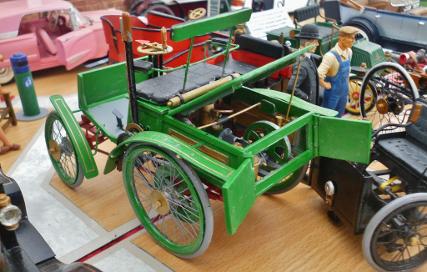
Benz Truck and Bus
Benz then turned his attention to other ways of using the design.
In 1895 a lorry version of the Victoria was put on sale, a world first, followed by a development of that vehicle to create the world’s first motor buses.
With these vehicles the Netphener bus company commenced a regular service between Siegen, Netphen and Deuz.
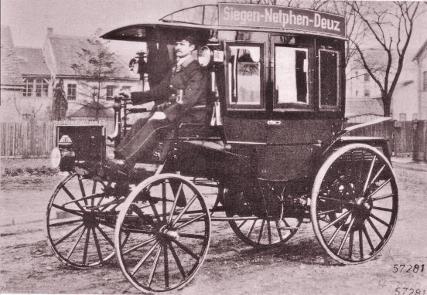
Benz flat (boxer) engine
Innovation at Benz & Cie. continued at a frenetic pace. In 1896 Benz developed the "contra" engine for which he was granted yet another patent. The design laid the pistons horizontally in opposition so the corresponding pistons reach top dead centre simultaneously, balancing their momentum against each other. This revolutionary flat engine design was the forerunner of today's horizontally opposed ‘boxer’ engine so popular in Porsche cars, used by many car and motorcycle manufacturers (most notably BMW) and still raced and rallied by Subaru and others today.
Another first that year was the arrival of the 1st automobile in the Netherlands, on the 19th of May, 1896; you guessed it, the motor car was a Benz. The astounding success of Benz & Cie. continues with the 1,000th Benz passenger car hitting the road the following year, 1897.
As the turn of the century approached Benz & Co. had grown into the world's leading motor car manufacturer producing 572 vehicles in 1899 alone. The vehicle workforce had grown from 50 in 1890 to 430 in 1899.
With the much greater financial issues, personnel and production figures the decision was taken to convert Benz & Cie., Rheinische Gasmotoren-Fabrik to a full joint-stock company in May 1899. Share capital three million marks was fixed, Max Rose became chairman with Mannheim bank director Dr. Richard Brosien as vice chair. Directors were Julius Ganß and Carl Benz backed up by Josef Brecht and Eugen Benz who had general commercial power of attorney.
First Benz racing car
The first true racing design from Benz capped off this decade of expansion. On the 2nd of July 1899 8hp Benz racing cars, powered by flat 2-cylinder ‘Contra’ type engines, won 1st and 2nd in class, and a Gold Medal, in the 193.2km endurance race held between Frankfurt and Cologne, despite muddy roads, rain gale force winds. Fritz Held set an average speed of 22.5kph, followed home by Emil Graf.
Benz cars had more good results in 1899 too. On the 23rd of July, 1899, Fritz Held took 2nd place in the Innsbruck-Munich race. The car now having been tuned to give as much as 12hp. On the 11th of September, 1899, another Benz car was driven to victory in Italy at the Treviso–Oderzo–Codogne–Conegliano–Treviso by Andrea Antonini. Back in Germany on the 12th of September, 1899, a Benz car won in the Berlin-Baumgarten-Berlin race and a week later on the 20th of September, 1899, Fritz Held & Richard Benz drove a Benz car to first place in the Berlin-Leipzig race.
It is also important to remember Benz were supplying engines to many of Europe’s budding car builders. In Austria Theodor Baron von Liebieg won the first International Race in Vienna driving an NW Präsident car, based on the Benz Victoria design and powered by a 5.9kW Benz engine.
This 1899 type racing car developed further and put into the 1900/01 production catalogue at a price of 15,000 marks. The engine was a 2280cc, 2-cylinder ‘Contra’ motor, each cylinder having a bore/stroke of 110x120mm. These cylinders were consisted of a cast iron cylinder with laterally arranged cylinder valve box and a common open crank area. The fuel mixture was created through a spray nozzle carburettor. 1 vacuum operated intake valve and 1 camshaft operated exhaust valve per cylinder allowing the unit to run on the four-stroke principle. A closed cooling system from a mechanical water pump was fitted and lubrication was from a central oiler system. There was no generator fitted so Ignition was provided by high voltage trembler ignition from a battery. Situated transversely in the mid-rear location the unit was rated at 16hp @ 1000rpm. It boasted four forward gears, and a reverse gear, and weighed 1150kg.
With these cars the Benz brand continued to have success. Fritz Scarisbrick from Hanau drove one of these ‘off the peg’ Benz racing cars to 2nd place in the Eisenach-Oberhof-Meiningen-Eisenach mountain tour covering 136km in 4hrs23min’s setting an average speed of 30.1kph. At one point the car even achieved a top speed of 65kph. Benz were quick to capitalise on this success using the slogan “The car will manage any ascent” in advertising.
The Benz works racing cars for 1900 were 20hp rated horizontally opposed four-cylinder engined beasts developed for Benz & Cie. by Georg Diehl. The important part of these cars design was the inclined steering-column and steering wheel, a major improvement over the horizontal steering handle and following the 1898 racing innovation from Panhard et Levassor. The 20hp Benz ‘Rennwagen’ proved to be very competitive with Benz designer Georg Diehl & Benz chief mechanic Mathias Bender both winning races driving Benz cars in 1900. The successes of 1900 could not be matched in the coming years, largely due to the Jellinek designed Daimler-Motoren-Gesellschaft (DMG) cars from Cannstatt being so very good.
What we are seeing as the point at which all automobile firms were starting to create specialist cars for racing over simply using their production cars in a test of which brand was best. The real growing pains of motor racing were now beginning. Benz cars had been involved in competitive events since the 2nd of November, 1895 when H. Mueller, of Decatur, Illinois, drove a Benz Gasoline Motor car in a race against Mr. Duryea, of Springfield, Massachusetts, driving a Gasoline Motor Wagon of his own Duryea brand. The Benz completed the course from Washington Park Chicago to Waukegan, Illinois, and back to the Grant Monument in Lincoln Park, Chicago; some 92miles in all. There was a time limit of 13hrs just to make it fun but the Benz of Mr. Mueller took just 9.5 hours. A few weeks later at the Chicago Thanksgiving Day event Mr. Mueller’s Benz was second. However up until 1899 these had been the current production cars.
Inside of ten years Benz & Cie became the world’s largest automobile company, employing more than 400 full-time staff and selling around 600 vehicles a year. The Waldhofstraße plant had gobbled up neighbouring plots of land to around 30,000 square meters spewing out 603 cars in 1900. Innovations in race car design, mass production, and clever engine design would keep Benz & Cie. at the forefront of automotive production in the long-term while Benz was becoming the world’s first legally licensed driver, an honour conferred upon him by Grand Duke of Baden in 1900, things were starting to become difficult for Benz, the man, and his company.
Plans for a new, even larger, production facility on the outskirts Mannheim were shelved when Benz sales collapsed, again due to pressure from Daimler’s state-of-the-art Mercedes designs, creating a financial crisis. Benz cars had begun to feel out of date and underpowered yet Karl Benz outdated and outmoded. Karl Benz resisted change of any sort and was opposed to more motor racing designs. Benz’ own idea was that service vehicles, trucks and busses etc were the way forward, which makes a certain amount of sense as the numbers of people who could a motor car were limited at the time, and as a result these larger vehicles didn’t need to go fast; also a fairly sensible thought. Carl Benz’s sceptical attitude might have been something to do with being based in Germany rather than France. In 1894 the world’s first automobile competition, in France, had several thousand spectators while the Berlin motor race of 1898, just four years later, had very few people showing any interest. The automobile grew massively in France but in Germany the enthusiasm for motoring was as slow to pick up as that of the German appetite for motor racing.
Benz commercial director, Julius Ganß was keen to see Benz & Cie. modernise and reclaim their position as the best vehicles available through a programme of technical innovation. The board tussled with the different approaches but Benz would not bow to the consensus. Julius Ganß, and some other members of the board went behind Benz’ back to bring in the designer-in-chief of French company Clément-Barbarou, and his closest colleagues, in 1902. This effectively created two ‘design bureaus’ in the firm, a French one with Marius Barbarou et al, and a German one Georg Diehl and Fritz Erle, both endeavouring to create new models. While the French design engineers clearly had extensive industry knowledge, based around Maybach's Daimler designs, they could not effectively marginalise the German design department. There was competition between the designer schools and conflict in the boardroom. The whole firm was suffering.
1903 Benz Parsifal
Neither design department could assert itself so when the new 1903 design emerged it was a combination of ideas from both sides. Designated "Parsifal" the new model series had a range of upright in line 2-cylinder engine sizes, 8-10 & 12hp, and an inline 4-cylinder model rated at 16hp, Benz’ first 4-cylinder production car. A four-stroke motor with bore and stroke of 100x110mm displacing 1727cc gave an output 10-12hp @ 1280rpm. It continued to have an automatic inlet valve with the exhaust valve operated by a lateral camshaft driven by spur gears. Fuel was mixed through a spraying nozzle carburettor. Power was directed to the rear wheels via a drive shaft with final drive being by roller chains. Top seep was an acceptable 37mph, (60kph).
The design moved the motor car away from the image of a carriage ‘sans chevaux’. The engine having moved to the front of the chassis and the whole vehicle was lower to the ground facilitating handling characteristics and driver/passenger accessibility.
There was a special state-of-the-art racing car was designed by Marius Barbarou off the back of the Parsifal car. It was made as light as possible with the aim of competing with the Mercedes racers, the engine particularly being much lighter than the Mercedes engines. This four-cylinder in-line engine displaced a whopping 11.2ltrs pushing out a creditable 60hp. Given the overall weight of 782kg. The power to weight ratio was very good making the car capable of speeds over 100mph.
However, the car didn’t get much of a chance to shine. It did compete in the ill-fated 1903 Paris–Madrid race, terminated at Bordeaux due to the number of deaths and accidents, but never started another long-distance event. There was a victory though when, on the 19th of June, 1903, the car averaged 119.8kph at the Huy 1km race in Belgium. In both these events it was the designer Barbarou himself who drove the car.
Benz resigns
Karl Benz and Julius Ganss could not settle their differences of opinion, particularly over the ‘French design influx’ of 1902. After several difficult discussions Karl Benz announced his retirement from active work within Benz & Cie. on the 24th of January, 1903. Benz took a seat on the Supervisory Board, remained a director through the Benz-DMG merger of 1926 only relinquishing the position upon his death in 1929.
At the same time Benz resigned his sons, Eugen and Richard, also left the firm, although Richard returned to Mannheim in 1904 as passenger car production manager. The ‘Parsifal’ design was thoroughly overhauled in 1904 and Fritz Hammesfahr became technical director of the Benz production facilities. Sales of Benz cars started to climb again reaching 3480 units by the end of the year. Benz & Cie. spent 1905 consolidating of the model range as the financial upswing continued and the new designs caught up with the level of automotive technology. Karl Benz himself began looking for something new to fill his time.
"Carl Benz Söhne" (1906–1923 (Carl Benz & Son)
During the early years of Benz & Cie. Karl had taken out the cars for test and development drives often finding himself in the small town of Ladenburg, 10km (6.2mi) east of Mannheim. Enchanted by the area he purchased a farmland plot, No. 4069, in 1898. In 1899 Karl purchased 10 more plots amassing a sizable parcel of land in Ladenburg. In 1905 Bertha Benz bought the Ladenburg estate of dwelling house and outbuildings formerly owned the wife of Heidelberg brewery owner Christian Friedrich Leonhard. The Benz family were establishing themselves in Ladenburg relocating there in 1906 with the idea of setting up a new factory to produce engines there.
Carl and his son Eugen Benz founded a new company "Carl Benz Söhne" (using the French variant of Benz's first namw, "Carl") in Ladenburg and, with, who became the joint owner. Being a private company founded solely with their own funds the firm was completely independent never issuing stocks publicly or being in anyway related to Benz & Cie. Initially Carl and Eugen planned to build naturally aspirated gas engines but the world had moved on and Benz found it hard to attract customers. Instead they produced petrol engines and fell back on their foundation of motor vehicles.
The "Carl Benz Söhne" line of vehicles were good quality machines although sales figures were never going to trouble Daimler MG or Benz & Cie. In 1912 Carl Benz was getting close to end of his sixth decade of life and decided to withdraw from the company. Liquidating all his shares Carl left the firm in the hands of Eugen and Richard. Benz’ Sons continued to expand the firm creating new sales systems and export opportunities. Notably in Britain where the Benz Söhne brand found favour as London taxis due to being solid and reliable vehicles.
Between 1906 and 1923, the last year of production, some 350 Benz Söhne vehicles were produced. That said in 1924 two more 8/25hp Benz Söhne automobiles, tailored to his personal requirements, were manufactured solely for Carl Benz’ personal and business use. They were never sold and both are still preserved today.
Later years
When Carl Benz reached his 70th birthday there was a special birthday celebration held for him in his home town of Karlsruhe. On the 25th of November, 1914, Benz was awarded an honorary doctorate from the Karlsruhe University where he had studied so many years ago.
Dr.Ing.h.c. Karl Benz should have been enjoying his retirement now, and while no longer active in the “Carl Benz Söhne” firm Carl Benz was still on the board of the “Benz & Cie.” company. Furthermore, the world had been plunged into the maelstrom of the First World War. When the chaos of war ended both DMG and Benz & Cie. returned to vehicle production but the German economic situation was in crises. A 15% extra tax was attached to what were considered luxury items.
Carl Benz attempted to persuade the two firms to co-operate with each other through an intermediary, Karl Jahn, in 1919 but DMG rejected the idea. The German economic crisis continued to deepen and in 1923 Benz & Cie. produced just 1,382 units in Mannheim; DMG did even worse, only 1,020 vehicles being produced in Stuttgart. The intense competition between Benz and Daimler, a severe shortage of petrol and the inflated average car price of 25,000,000Dmarks, were hurting both firms. Negotiations resumed.
An ‘Agreement of Mutual Interest’ was signed between the two firms on the 11th of May, 1924, followed by a full merger two years later on the 28th of June 1926. A new Brand logo was created featuring the three-pointed star (representing Daimler's motto: "engines for land, air, and water") surrounded by the and the traditional Benz laurels with the legend, Mercedes-Benz.
The elderly Carl Benz took up a position on the Daimler-Benz company Board of Management, a position he relinquished only on his death in 1929.
Death
Carl Benz died on the 4th of April, 1929 in his home in Ladenburg near Mannheim, Baden, Germany. He was 84 years old and succumbed to bronchial inflammation. Bertha continued to live in the house until her death on the 5th of May, 1944, at the age of 95. Other members of the family remained in residence at the house another thirty years.
Both Carl and Bertha now rest together in the Cemetery of Ladenburg, Rhein-Neckar-Kreis, Baden-Württemberg, Germany. A very hansom monument and headstone stand as a lasting memorial to the couple.
Accolades and memorials
As you might expect of such an important figure in history there are many memorials to Karl Benz and his achievements, too many to mention them all. We will start with two items from Karlsruhe, Karl Benz’ home town, then include some of the others that can be found in Europe and finish with some items that will leave you in wonder.
The house where Karl Benz was born no longer exists as the Rheinstrasse was widened in the 1950s the site now having department store and car park on it. Of course, there is a memorial to the inventor in the area. The Karlsruhe Plaque of Karl Benz has a Germany inscription which reads:
Dr. Carl Benz
26. November 1844 - 04. April 1929
- ERFINDER DES AUTOMOBILS -
STUDENT
DES POLYTECHNIKUMS KARLSRUHE VON 1860-1864
EHRENDOKTOR
DER TECHNISCHEN HOCHSCHULE KARLSRUHE 1914
----
Inventor of the automobile
Student
of the polytechnic university of Karlsruhe in 1860-1864
Honorary
Doctor of the Technical High School Karlsruhe 1914
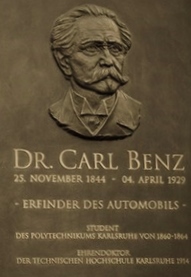
As well as the honorary doctorate from the Karlsruhe University given Benz in 1914, in a formal celebration in 2007 the Karlsruhe Institute of Technology renamed its Mechanical Engineering College the “Carl Benz School”. Former KIT Prof. Dr. Horst Hippler, Chairman of Mercedes-Benz Dieter Zetsche officially inaugurated the new title in the presence of Carl Benz’ great-granddaughter Jutta Benz. The title is meant to inspire generations of engineers to emulate the innovative mindset of the great man himself. This seems most fitting as Benz himself once said “The things I have aspired to and created all have roots which lead back to this institution.”
In 1933 a large Carl Benz memorial in Mannheim was erected @ Augustaanlage 9, 68165 Mannheim, Germany. The bronze relief and replica of the first Benz car was created by prof. M. Laeuger, a famous artist of the period.
A Cast Iron Bust of Carl Benz created by Ernst Rausch was made in 1938 (along with one each for Daimler, Maybach and Bosch) for the Deutsches Museum exhibit honouring the motorcar.
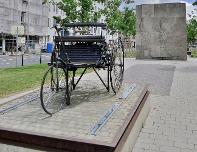
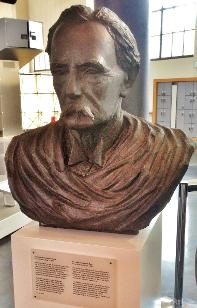
In the town of Ladenburg where the family resided from 1906 there are several places of interest set up in memory of Benz and his cars.
Carl Benz House, were members of the Benz family lived until 1968, still exists at the Carl Benz Square being designated an historic landmark. It transferred to the town of Ladenburg in 1969 and was repurposed to be used as a restaurant and meeting place for clubs and associations. In 1985 Daimler-Benz purchased the building and thoroughly refurbished it. Today it is the registered office of the non-profit Daimler and Benz Foundation which was set up in 1986 to promote development through scientific findings and is sometimes used as a conference centre.
The house can be visited to see its exhibits, documents, personal memorabilia and models related to the life and the work of Benz. It endeavours to imbibe the personal motto of Benz:
"Inventing is much more agreeable than having already invented."
The “Carl Benz Haus” can be found at Dr.-Carl-Benz-Platz 2, 68526 Ladenburg, Baden-Wurttemberg, Germany.
In the grounds of the house is also the garage Carl Benz had built in the style of an old fortified tower in 1910. It is a two-story building consisting of a ground floor garage, the first known building planned to house a motorcar (as such the oldest garage in the world), and an upper floor that was Benz study and work room right up to his death in 1929. The building was refurbished in 1986 by Elbe-Benz family and is today maintained by the Motorsportclub Dr. Carl Benz e.V. ADAC. Beside the Tower Garage there is a memorial monument which has an inscription which reads:
Carl Benz 1844-1929
"For the memory of the inventor of the petrol engine car from the citizens of Ladenburg".
When Carl Benz turned Ladenburg into a synonym for progress in 1908 one can only wonder what the local people thought. The C. Benz Söhne plant in Ladenburg remains to this day. Painstakingly restored, and somewhat remodelled, through generous donations from Mecedes-Benz AG, it is now an industrial monument honouring Benz.
The Dr. Carl Benz Car Museum, stands at Ilvesheimer Straße 26, 68526, Ladenburg, Baden-Wurttemberg, Germany. The original Museum collection was put together in 1984 and steadily grew. It moved into the old C. Benz Söhne factory in 2005. Over 80 vehicles and models are on display including the last two Benz Söhne vehicles built for Carl Benz himself. Countless memorabilia artefacts, a wealth of historic documents and exhibits from the Benz family can be seen in the numerous showcases.
Many thousands of cars have motored to Ladenburg to pay homage to the godfather of the modern motor car, and as part of a wider tour of German automotive history. Although Benz died in 1929, he is far from forgotten in Ladenburg.
Perhaps the greatest act of honour bestowed upon Carl Benz was his induction into the U.S. Automotive Hall of Fame in 1984. The United States itself has several steam vehicle pioneers so to find a European held in high esteem says a lot.
When Europe caught up with the idea in 2001 ‘The European Automotive Hall of Fame’, found in Geneva, Switzerland, was opened. This was thanks to the joint efforts of the Geneva Motor Show and ‘Automotive News, Europe’ magazine. Inducted in the first class of inductees were both Carl Benz and Gottlieb Daimler.
At this time the European Automotive Hall of Fame has over 50 inductees denoting the automotive industry achievements across all eras.
The life of Karl and Bertha Benz was made into a dramatized television movie, called “Carl & Bertha”, in 2011, and a special "making of" behind the scenes film and movie trailer can be found on YouTube.
Finally, as well as the European countries you might more readily expect to have released stamps commemorating Karl Benz and his cars, many more obscure countries have also produced Benz related stamps; including some countries I’ve never heard of! Japan, Afghanistan, Albania, Cuba, Uganda, Gambia, Republic of Congo, Rwanda, Malawi, North Korea (!), South Korea, Antigua & Barbuda, Guiné-Bissau, San Vicente, Burundi and Comoros.
Conclusion – Legacy
The credit for inventing the automobile can’t fairly be attributed to any one man as it was the sum of development knowledge from many fields of endeavour through the 1800s. However, Carl Benz, by virtue of his 1886 patent for the Motorwagen and the string of individual patents for constituent parts used on his internal combustion engine powered Patent Motorwagen, can be considered the first real designer of a commercially viable motor vehicle.
Without doubt is the fact that the world has been revolutionized by the motor vehicle. From personal transport to goods and construction vehicles most everything is transported by road courtesy of the internal combustion engine. The motor industry is massive world-wide, as an employer and innovator it continues to develop and grow in popularity. All thanks to the man who created a brand with a reputation for quality.
Carl and Bertha Benz were more than engineer and entrepreneur they were dreamers and pragmatists at the same time. Seeing the possibilities for the motorcar while realising it needed to be a sound and reliable design it was the Benz couple that would inspire, and by selling engines on the same way Daimler did, make it possible, for other engineers around the world to take up the batten of motorisation.
Often referred to as the father, and mother, of the motor car, there is little doubt the Benz’s made an enormous impression on the world, through intuitive design and flamboyant marketing. The claim that others actually made the first car may be true; but only the Benz’s made it into a useful prospect, creating not only a product, but the market for it too.
While Gottlieb Daimler died in 1900 and never saw the motoring revolution take hold, Carl Benz lived to see his idea become a world phenomenon. We can only wonder what he would say if he could see the number of vehicles traversing the world’s roads today. One seriously doubts Benz, Daimler, or even the Wright Bro’s, had the slightest inkling of the environmental consequences that powered transport would unleash on the world.
One quote from Karl Benz still resonates in the design rooms of the world’s auto plants to this day, “the love of inventing never dies.” It never died for Benz and the idea shows no signs of dying today.
RETURN TO :-
